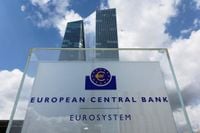The European Central Bank (ECB) has cut the eurozone interest rate for the seventh time since June 2024, reducing it by a further 0.25 percentage point to 2.25%. The announcement was made at the bank's headquarters in Frankfurt on Thursday, April 17, 2025. This latest cut aligns with analysts' expectations, as lower rates make borrowing cheaper for banks, which can translate to lower costs for consumers and businesses.
The ECB's decision comes amid growing concerns about economic growth, which the bank attributes to escalating trade tensions, particularly those stemming from U.S. policies. "The outlook for economic growth has deteriorated as a result of escalating trade tensions," the ECB stated. The bank further noted that rising uncertainty is likely to dampen both household and business confidence, while volatile market reactions could tighten financing conditions, putting additional pressure on the economic outlook.
Support for further easing of monetary policy grew significantly after U.S. President Donald Trump announced steep import tariffs. Although many of these tariffs have been put on hold for 90 days, the potential for a 20% tariff rate on European goods continues to worry economists and policymakers. The fear is that such tariffs could lead to increased costs, ultimately dragging down business activity across the eurozone.
As the ECB navigates these turbulent waters, inflation has also been on a downward trend, falling towards the bank's target of 2%. In March 2025, inflation was recorded at 2.2%, a figure that, while close to the target, remains stubbornly high. Investors are now anticipating two to three more rate cuts by the end of the year, reflecting the market's response to both the ECB's actions and external pressures.
In the context of these financial adjustments, the eurozone economy grew by a mere 0.2% in the last quarter of 2024, highlighting the sluggish growth that has prompted the ECB to act. ECB President Christine Lagarde had previously hinted at a possible pause in rate cuts during the bank's last meeting on March 6, 2025. However, the situation changed dramatically following Trump's tariff announcements, which effectively closed the door on any immediate pause in the bank's rate-cutting strategy.
The ECB's decision to continue lowering rates reflects a broader strategy to stimulate the economy amid fears of stagnation. As the central bank grapples with these challenges, it remains to be seen how effective these measures will be in restoring confidence within the eurozone. The interplay between U.S. trade policies and European economic stability is a delicate balance that will require careful monitoring in the coming months.
Market analysts are keeping a close watch on the ECB's next moves, as the geopolitical climate continues to evolve. The ongoing uncertainty surrounding trade relations and inflation dynamics poses significant challenges not just for the ECB, but for the entire eurozone economy.
In summary, the ECB's decision to cut interest rates for the seventh consecutive time underscores the urgency of addressing economic growth concerns in the eurozone. As trade tensions escalate and inflation remains a critical factor, the central bank's actions will be pivotal in shaping the region's economic trajectory in the months to come.






